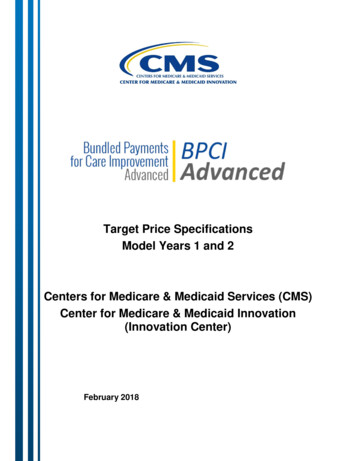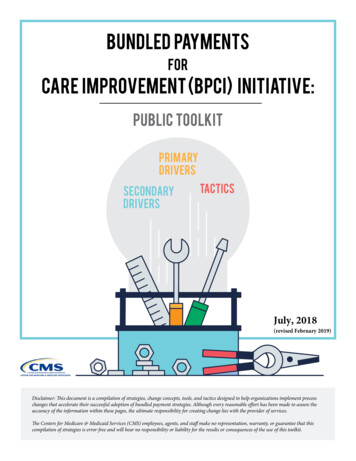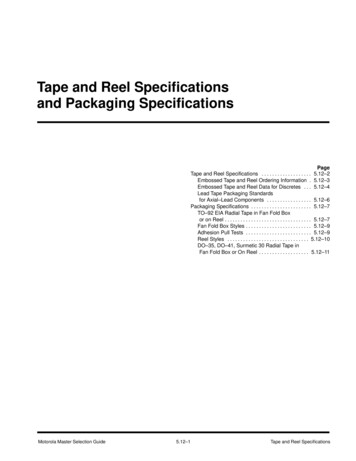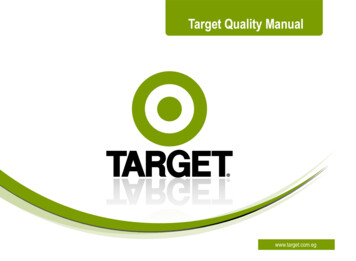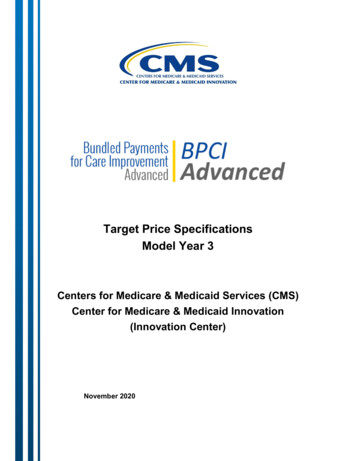
Transcription
Target Price SpecificationsModel Year 3Centers for Medicare & Medicaid Services (CMS)Center for Medicare & Medicaid Innovation(Innovation Center)November 2020
[This page is intentionally left blank.]BPCI Advanced Target Price Specifications – Model Year 3 November 2020 2
TABLE OF CONTENTS1234Inputs . 4Target Price Overview . 6Clinical Episode Construction Background . 8Steps In Target Price Construction . 104.1 Patient and Peer Group Risk Adjusters. 104.1.1 Patient Case Mix Adjusters . 104.1.2 Peer Groups. 124.2 Estimate Model of Clinical Episode level Spending . 154.3 Obtain ACH and PGP Target Prices . 214.3.1 Formulation of the Preliminary Hospital Benchmark Price . 214.3.2 Formulation of the Preliminary PGP-ACH Benchmark Price . 234.3.3 Create Preliminary Target Prices . 264.3.4 Create Final Target Prices. 27Appendix: MJRLE Benchmark Price Construction. 28LIST OF TABLESTable 1: Target Price and Setting-Specific Update Factor Datasets . 4Table 2: Patient Characteristics Categories used to Risk Adjust BPCI Advanced Target Prices. 11Table 3: Peer Group Characteristics used to Construct BPCI Advanced Target Prices . 12Table 4: Clinical Episode Category Level Participant Eligibility Examples . 16Table 5: Model Estimation - PCMA Input Calculation . 18Table 6: Model Estimation - PGHA and PGT Input Calculations. 19Table 7: Model Estimation - SBS Input Calculations . 20Table 8: Preliminary HBP Calculation . 22Table 9: Components of the Preliminary HBP . 23Table 10: Preliminary PGP-ACH Benchmark Price Calculation . 25Table 11: Components of the PGP-ACH Benchmark Price . 26Table 12: Preliminary ACH Target Price Calculation . 27Table 13: Preliminary PGP-ACH Target Price Calculation . 27Appendix Table 1: Example of how costs will be edited for selected Clinical Episodes . 29BPCI Advanced Target Price Specifications – Model Year 3 November 2020 iii
1 INPUTSTable 1: Target Price and Setting-Specific Update Factor Datasets#NameSourceDescriptionTarget Price Datasets1234567The national set of Clinical Episodes,constructed using the methodology described inBPCI Advancedthe specifications document. Additional inputsBPCI Advanced Clinical EpisodeNational Clinicalto this file include: Common Working FileSpecifications DocumentEpisodes(CWF), Medicare Enrollment Database (EDB),and Official CMS Standardized AllowedAmounts.The Participant List identifies the Convener andNon-Convener Participants and the ClinicalEpisode categories they have selected toBPCI Advancedparticipate in for the BPCI Advanced model.CMSParticipant ListNote: The Applicant List will be used initiallyto construct preliminary Target Prices while theParticipant List will be finalized and usedstarting with the December update.The Provider of Services (POS) Extract iscreated from the QIES (Quality ImprovementEvaluation System) database as of er 2011 and all future POS files. The fileProvider of tains an individual record for each(POS) -approved provider and is updatedquarterly. The file includes information for allinstitutional providers, Ambulatory SurgicalCenters (ASCs), and Clinical -FeeThe file contains information about the factsFor-ServiceProvider Specificspecific to the provider that affect computationsPayment/ProspMedicareFeeSvcPmtGen/psf SFiles (PSF)for Prospective Payment Systems.AS.htmlMajor teaching hospitals are identified byrestricting the hospitals in the PSF to those withan intern to bed ratio of greater than or equal toMajor TeachingCMS0.25.Hospital (MTH)Note: This variable replaces the AcademicMedical Center (AMC) variable used in ModelYears 1&2.The CME contains comprehensive data onindividuals in the Medicare program. ItCommon Medicareprovides information on insurance coverage andEnvironmentCMSMedicare health plan and demonstration(CME)programs in addition to information aboutMedicare Parts A,B,C and non-subsidy Part Dbeneficiaries.Long TermThis file includes information on beneficiariesMinimum DatasetCMSthat are institutionalized long term.(MDS)BPCI Advanced Target Price Specifications – Model Year 3 November 2020 4
#NameSourceDescriptionSetting-Specific Price Update Datasets891011121314InpatientThese inputs are used to update historical pricesProspectivefor the IPPS setting. Updated base rates andPayment System https://www.cms.gov/Medicare/Medicare-FeeMS-DRG weights are used as per the most(IPPS) Base Rates for-Service-Payment/AcuteInpatientPPS/IPPSrecent IPPS Final Rule and Correction NoticeRegulations-and-Notices.htmland MS-DRGavailable on this page.WeightsGPCI eePractice Cost I), RelativeFederal-Regulation-Notices.htmlValue UnitsSee Final Rule AddendaThese inputs are used to update historical prices(RVU),RVU/Physician CF:for the PFS e/Medicare-Fee- See most recent Final Rule/Relative Value FileCrosswalk, ble on these pages.Physician andRelative-Value-Files.htmlAnesthesiaAnesthesia CF:Conversion .cms.gov/Medicare/Medicare-FeeThese inputs are used to update historical pricesRehabilitationfor-Servicefor the IRF setting as per the most recent IRFFacility (IRF)Payment/InpatientRehabFacPPS/IRF-RulesFinal Rule available on this page.Conversion Factorand-Related-Files.html(most recent csData-and-Systems/Statistics-Trends-andThe MEI is used to update historical prices forEconomic Indexthe “Other” setting.(MEI) (most recent .htmlonly)Skilled NursingFacility (SNF)These inputs are used to update historical e-Fee- for the SNF setting from the previously usedUtilization Groupsfor-Service-Payment/SNFPPS/List-of-SNFRUG-IV payment model to the new PDPM(RUG) and PatientFederal-Regulations.htmlmodel as per the most recent SNF Final RuleDriven Paymentavailable on this page.Model (PDPM)weights and Service-Payment/HomeHealthPPS/HomeHome HealthHealth-Prospective-Payment-SystemThese inputs are used to update historical pricesResource GroupRegulations-and-Notices.htmlfor the HHA setting from the previously used(HHRG) andHH PPS base rates:HHRG payment model to the new andmodel as per the most recent HH Final RuleGroupings ModelGuidance/Guidance/Transmittals/available on this page.(PDGM) base ratesHHRG weights:and r-Service-Payment/PCPricer/HH.htmlAddendum B and Jhttps://www.cms.gov/Medicare/Medicare-Feefrom the Outpatientfor-ServiceThese inputs are used to update /Hospitaltrigger prices for the OPPS setting.Payment ) Final RuleBPCI Advanced Target Price Specifications – Model Year 3 November 2020 5
2 TARGET PRICE OVERVIEWThe following document describes the methodology used to calculate Target Prices forthe BPCI Advanced model. The BPCI Advanced Target Prices are constructed to satisfy thefollowing essential features: Encourage both high and low cost providers to participate; Reward Participants’ improvement over time; Adjust for patient case mix that is not under the control of providers; Allow for levels of Clinical Episode spending that are distinct according toproviders’ regions and other relevant provider characteristics Allow for trends in Clinical Episode spending that are distinct according toproviders’ regions and other relevant provider characteristics; and Induce Medicare savings while maintaining high quality care.To satisfy these essential features, spending is risk-adjusted for patient characteristics;providers are benchmarked against providers with similar hospital-level characteristics,henceforth referred to as peer groups; 1 and individual historical patterns of risk adjustedspending relative to the provider’s peer group are taken into account. This methodology providesboth those Participants who have been historically low-cost providers and those who have beenhistorically high-cost providers with an incentive to lower costs over time and to benefit from thefinancial incentives of the BPCI Advanced model. 2The methodology produces Benchmark Prices, represented in official CMS standardizedallowed amounts, for participating acute care hospitals (ACHs) and for participating physiciangroup practices (PGPs). Since PGPs may initiate Clinical Episodes at multiple ACHs, PGPs mayreceive multiple Benchmark Prices, each built upon an ACH Benchmark Prices from a differentACH.The Hospital Benchmark Price (henceforth, HBP) is comprised of the followingcomponents, each of which is described in detail later in this document: Standardized Baseline Spending (SBS): This component accounts for the historicalspending adjustment of ACHs in the baseline period by calculating risk- and peerstandardized Clinical Episode spending in the baseline period.Peer groups are defined by the list of peer group characteristics within the regression models, as opposed to distinctgroups delineated by a single characteristic. See section 4.1.2 for more information.2Step 8 of Section 4.3.1 refers to historically low-cost providers as those who have lower Clinical Episode spending,relative to other Episode Initiators, for Clinical Episodes with the same patient and peer group characteristics.1BPCI Advanced Target Price Specifications – Model Year 3 November 2020 6
Patient Case Mix Adjustment (PCMA): This component adjusts for varying levels ofseverity in ACHs’ patient case mix that are outside the control of ACHs. Peer Group Historical Adjustment (PGHA) factor 3: This component adjusts forpersistent differences in patient case mix adjusted spending across peer groups overthe baseline period, projected forward to the end of the baseline period. Peer Group Trend (PGT) factor3: This component projects the standardizedspending from the end of the baseline period to the middle of Model Year 3 foreach peer group.Similarly, each PGP-ACH Benchmark Price is comprised of the following components: HBP: This component, as described above, provides the basic dollar value of thePGP-ACH Benchmark Price which is adjusted to account for: (i) the ACH historicalspending adjustment of the ACHs at which the PGP initiates Clinical Episodes, (ii)case mix of that ACH, (iii) peer group average case mix adjusted Clinical Episodespending, and (iv) peer group trends in case mix adjusted Clinical Episode spendingat the ACHs at which the PGP initiates Clinical Episodes. PGP Offset: The PGP offset measures a PGP’s risk- and peer-standardizedhistorical spending relative to the risk- and peer-standardized historical spending ofthe ACH at which the PGP initiates Clinical Episodes. Relative Case Mix: The relative case mix accounts for whether the case mix of aPGP’s Clinical Episodes at an ACH is expected to be more or less costly than theoverall case mix of Clinical Episodes at that ACH.The result of this methodology is a set of Target Prices that blends Participants’ historicalperformance with trends and levels in each Clinical Episode category’s spending for each peergroup. The Target Prices reflect each Participant’s level of Clinical Episode spending relative toexpected Clinical Episode spending for Episode Initiators with similar patient case mix andsimilar peer group characteristics.The following discussion describes the step-by-step implementation of the methodologyused to construct a Target Price for a given BPCI Advanced Clinical Episode category andEpisode Initiator.PGHA and PGT are the two components constituting the original Peer Adjusted Trend (PAT) factor that was usedin Model Years 1 & 2 to adjust standardized spending for peer group spending levels and trends. This decompositionof the PAT factor will not affect the values of Target Prices for Model Year 3 since the product of PGHA and PGTequals the PAT factor.3BPCI Advanced Target Price Specifications – Model Year 3 November 2020 7
3 CLINICAL EPISODE CONSTRUCTION BACKGROUNDWhile the purpose of this document is to describe how BPCI Advanced Target Prices arecalculated, this section provides some initial background on the preceding process ofconstructing Clinical Episodes. The Clinical Episode construction specifications describe how toconstruct Clinical Episode level spending, apply service-level exclusions, convert ClinicalEpisode level spending to Model Year dollars by applying setting-specific update factors, andcap outlier Clinical Episodes at the 1st and 99th percentiles within each MS-DRG or APC pooledfor each calendar year.The thirty inpatient, three outpatient, and one multi-setting 4 BPCI Advanced ClinicalEpisode categories are “triggered” by an admission to the inpatient setting with specific MSDRGs or a procedure performed in an outpatient setting with specific HCPCS. 5 ClinicalEpisodes are constructed to include all services that overlap the Clinical Episode window, withsome exceptions for services and supplies provided for certain readmissions, which are definedby MS-DRG, for some Part B drugs, which are defined by HCPCS, and for CardiacRehabilitation spending, which is identified by HCPCS and place of service. 6 Clinical Episodelevel payments are created by summing official CMS standardized payments for all nonexcluded services. 7 These standardized payments reflect the cost of services after removingvariation in spending arising from geographical adjustment of reimbursement in CMS paymentsystems (e.g. hospital wage index and GPCI) and from policy-driven adjustments (e.g. indirectmedical education (IME) adjustments). This process produces spending for each ClinicalEpisode in the baseline period, and henceforth all references to spending are assumed to be instandardized dollars unless noted otherwise as real dollars.Prior to estimating the model of Clinical Episode spending on data from the baselineperiod, standardized payments for each Clinical Episode are updated to Model Year dollars usingMS-DRG or APC specific updates for trigger spending, and setting-specific (e.g., IPPS, SNF,IRF, PFS, or HHA) price update factors for non-trigger spending. This allows the model toupdate the standardized allowed amount that providers would receive based on how inputs haveMajor Joint Replacement of the Lower Extremity (MJRLE) has been added as a new multi-setting Clinical Episodecategory in Model Year 3. Clinical Episodes in this category are triggered in both inpatient and outpatient settings,where the same Target Price will apply to Clinical Episodes triggered in both settings.5A complete list of the MS-DRGs and HCPCS that trigger a BPCI Advanced Clinical Episode can be found in the“Episode Definitions – Model Year 3” xls file. The following link will take you to the CMS BPCI Advancedwebsite.6A complete list of Clinical Episode exclusions can be found in the “MS-DRG Exclusions from Clinical EpisodesList” xls file. The following link will take you to the CMS BPCI Advanced website.7“CMS Standardization Methodology for Allowed Amount, Version 9.” Centers for Medicare & Medicaid Services(CMS), Acumen, LLC, April 2019. The following link will take you to the Quality Net website with thestandardization methodology.4BPCI Advanced Target Price Specifications – Model Year 3 November 2020 8
changed in the various Medicare payment systems while holding constant the mix of services inthe baseline period. This approach adjusts for inflation and is similar to the method used toupdate Target Prices in the Comprehensive Care for Joint Replacement (CJR) model.These inflation adjusted historical Clinical Episode spending amounts are in the samestandardized Model Year dollar terms as standardized Model Year Clinical Episodes andrepresent the basis for comparing Episode Initiator performance in subsequent sections. 8 Otherchanges in Clinical Episode spending, due to historical spending adjustment gains, peer grouptrends, or changes in patient case-mix, are discussed in subsequent steps of the model.The setting-specific prices update factors will be re-calculated to reflect the changes in Medicare payment systemsas more recent fee schedules become available during the Model Year of the model.8BPCI Advanced Target Price Specifications – Model Year 3 November 2020 9
4 STEPS IN TARGET PRICE CONSTRUCTIONThe following section presents the step-by-step methodology used to construct TargetPrices for both ACH and PGP Participants. Section 4.1 describes the risk adjusters used toestimate beneficiary- and peer-adjusted Clinical Episode level spending. Section 4.2 discussesusing the risk adjustment model used to estimate Clinical Episode spending. Finally, Section 4.3outlines how to use model estimates to obtain HBPs and PGP-ACH Benchmark Prices, whichare used to calculate Target Prices. For the Major Joint Replacement of the Lower Extremity(MJRLE) Clinical Episode category, the risk adjustment will be modified to account for theremoval of Total Knee Arthroplasty (TKA) from the IP-only list at the beginning of CY2018.For more details, please refer to the Appendix.4.1Patient and Peer Group Risk AdjustersFor all Clinical Episodes that overlap the BPCI Advanced model time periods, build arelevant set of patient and peer group characteristics to merge into the Clinical Episode level file.Note that in Stage 1 of the risk adjustment model, if a binary covariate is zero for less than 21Clinical Episodes in the baseline period, or one for less than 21 Clinical Episodes in the baselineperiod, then it is either removed from the risk adjustment model if there are no related covariates,or combined with the binary covariate representing the most similar group if there is a set ofrelated covariates (e.g. bed size). The covariates in Stage 2 of the risk adjustment model capturelevel diffe
Table 1: Target Price and Setting-Specific Update Factor Datasets . 4 Table 2: Patient Characteristics Categories used to Risk Adjust BPCI Advanced Target Prices. 11 . quarter 2011 and all future POS files. The file contains an individual record for each Medicare-approved provider an
